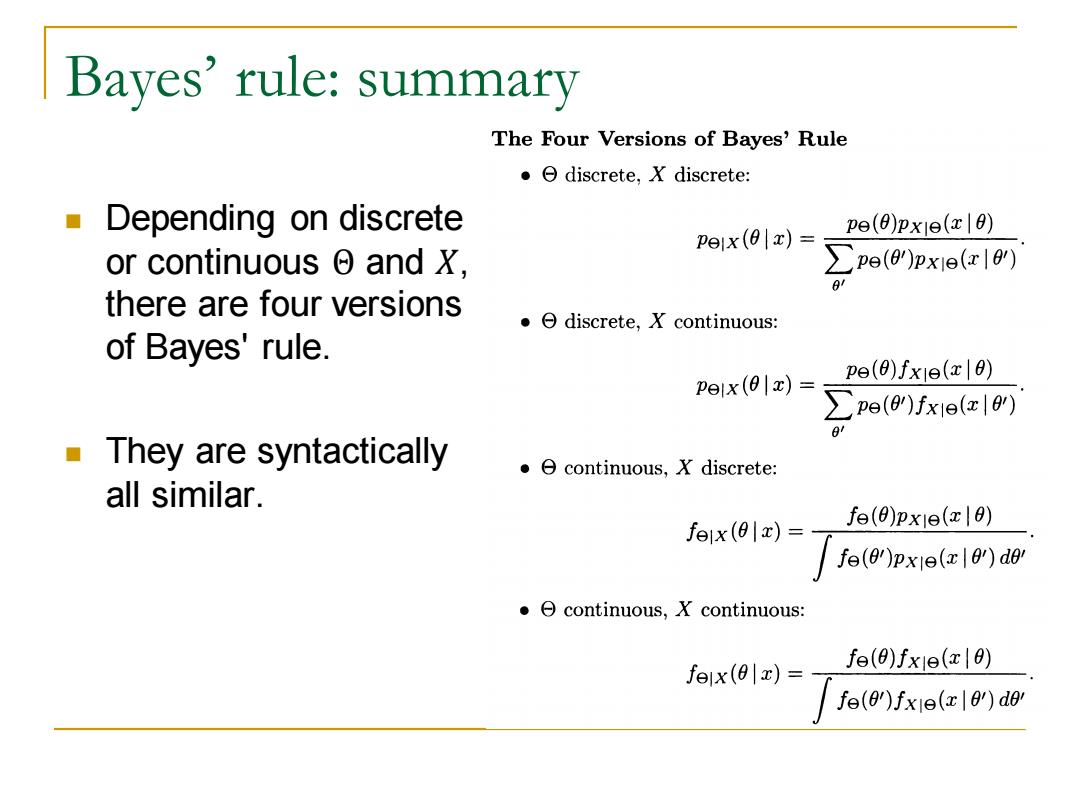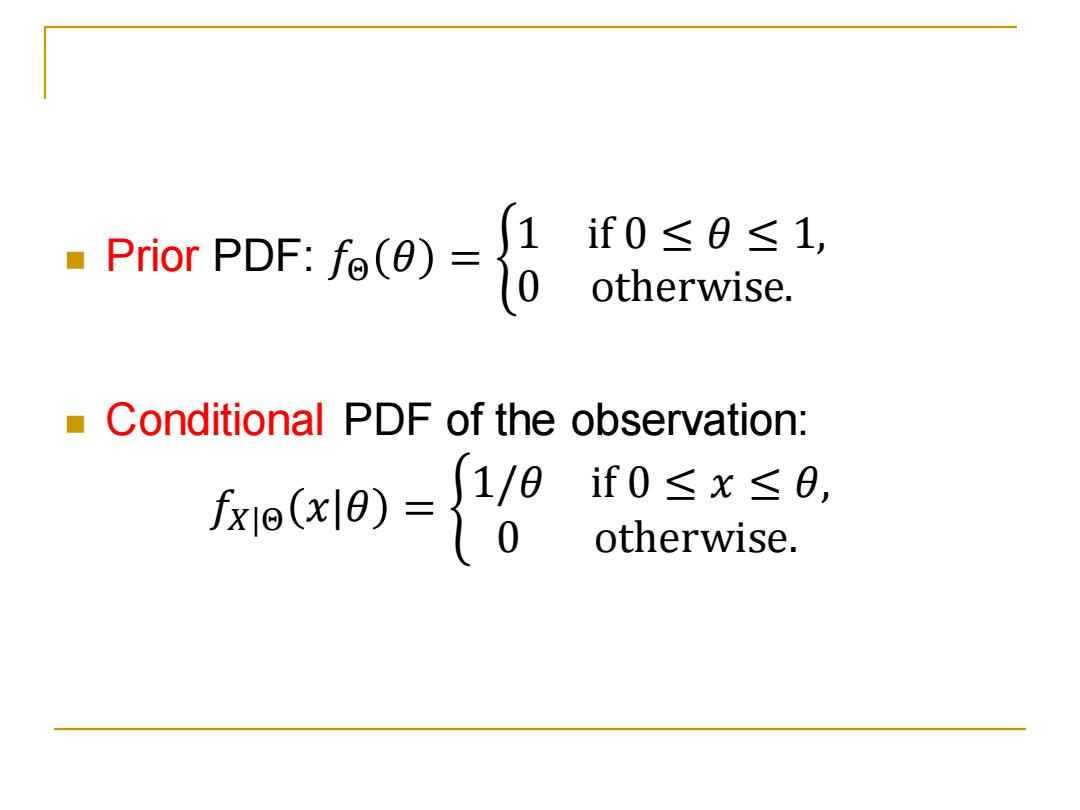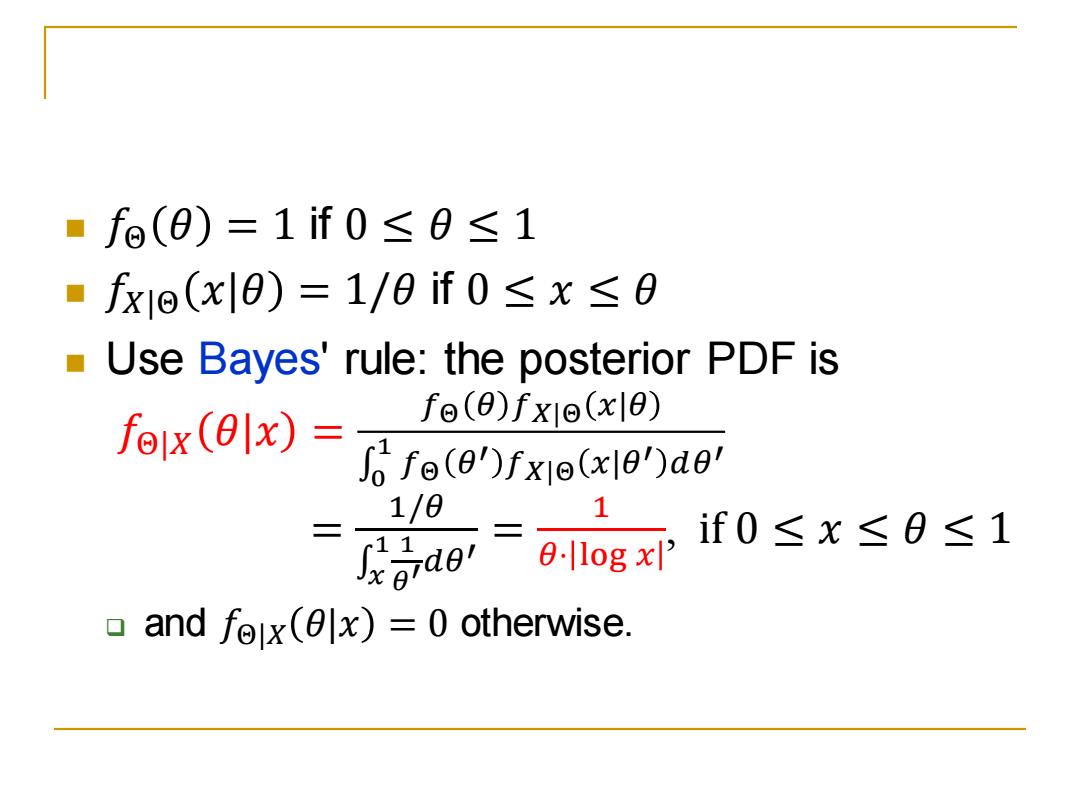
Summary of Bayesian Inference 1.We start with a prior distribution po or fe for the unknown random variable 6. 2. We have a model pxIe or fxio of the observation vector X. 3.After observing the value x of X,we form the posterior distribution of 6,using the appropriate version of Bayes'rule
Summary of Bayesian Inference 1. We start with a prior distribution 𝑝Θ or 𝑓Θ for the unknown random variable Θ. 2. We have a model 𝑝𝑋|Θ or 𝑓𝑋|Θ of the observation vector 𝑋. 3. After observing the value 𝑥 of 𝑋, we form the posterior distribution of Θ, using the appropriate version of Bayes' rule

Bayes'rule:summary The Four Versions of Bayes'Rule .e discrete,X discrete: Depending on discrete Pe1x(0|x)= pe(0)pxle(0) or continuous 6 and X. ∑Pe(0pxo(a9y) there are four versions .e discrete,X continuous: of Bayes'rule. Pe1x(0|x)= pe(0)fxle(x10) ∑pa(8)fx1o( They are syntactically .e continuous,X discrete: all similar. fe(0)pxle(10) feix(0|2)= jo(@)pxie(xI0)d0 .e continuous,X continuous: fe(0)fxle(x10) fa1x(81x)= fe(0')fx(1)do
Bayes’ rule: summary ◼ Depending on discrete or continuous Θ and 𝑋, there are four versions of Bayes' rule. ◼ They are syntactically all similar

Example:meeting Romeo and Juliet meeting:Juliet will be late on any date by a random amount X,uniformly distributed over the interval [0,0]. 0 is unknown and is modeled as the value of a random variable uniformly distributed in [0,1]. ■ Assume that Juliet was late by an amount x on their first date. Question:How should Romeo use this information to update the distribution of 0?
Example: meeting ◼ Romeo and Juliet meeting: Juliet will be late on any date by a random amount 𝑋, uniformly distributed over the interval 0, 𝜃 . ◼ 𝜃 is unknown and is modeled as the value of a random variable uniformly distributed in 0,1 . ◼ Assume that Juliet was late by an amount 𝑥 on their first date. ◼ Question: How should Romeo use this information to update the distribution of 𝜃?

-Por PF)-{日 if0≤0≤1, otherwise. Conditional PDF of the observation: fr0-{169 if0≤x≤8, otherwise
◼ Prior PDF: 𝑓Θ 𝜃 = ቊ 1 if 0 ≤ 𝜃 ≤ 1, 0 otherwise. ◼ Conditional PDF of the observation: 𝑓𝑋|Θ 𝑥|𝜃 = ቊ 1/𝜃 if 0 ≤ 𝑥 ≤ 𝜃, 0 otherwise

■fo(0)=1if0≤0≤1 ■fxIe(x|8)=1/8if0≤x≤8 Use Bayes'rule:the posterior PDF is feix(0lx)= f。(Θ)fxo(xl8) f(fxl(xl')a0 1/0 1 行dg-9-logx郊 if0≤x≤8≤1 oand feix(x)=0 otherwise
◼ 𝑓Θ 𝜃 = 1 if 0 ≤ 𝜃 ≤ 1 ◼ 𝑓𝑋|Θ 𝑥|𝜃 = 1/𝜃 if 0 ≤ 𝑥 ≤ 𝜃 ◼ Use Bayes' rule: the posterior PDF is 𝑓Θ|𝑋 𝜃|𝑥 = 𝑓Θ 𝜃 𝑓𝑋|Θ 𝑥|𝜃 0 1 𝑓Θ 𝜃′ 𝑓𝑋|Θ 𝑥|𝜃′ 𝑑𝜃′ = 1/𝜃 �� 1 1 𝜃′𝑑𝜃′ = 1 𝜃⋅ log 𝑥 , if 0 ≤ 𝑥 ≤ 𝜃 ≤ 1 ❑ and 𝑓Θ|𝑋 𝜃|𝑥 = 0 otherwise